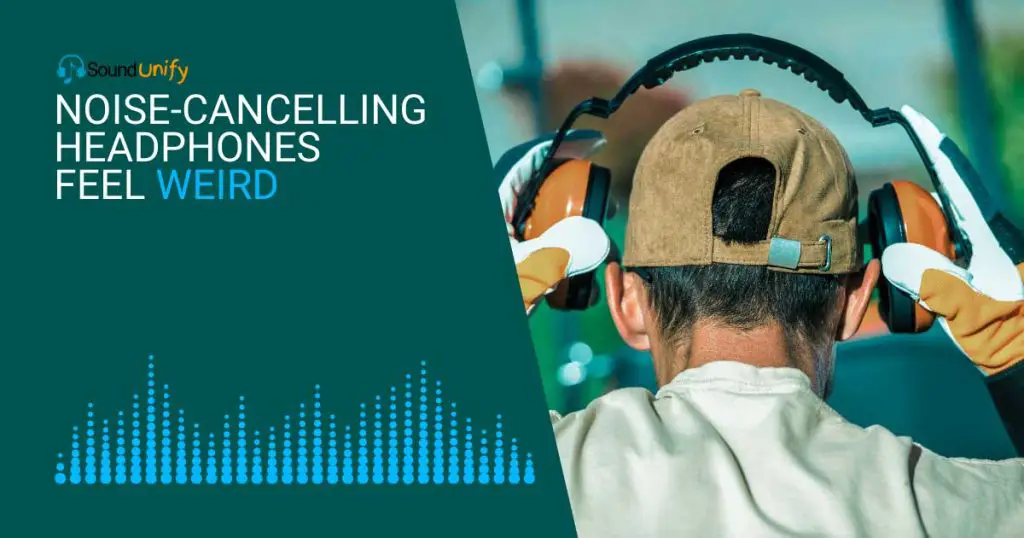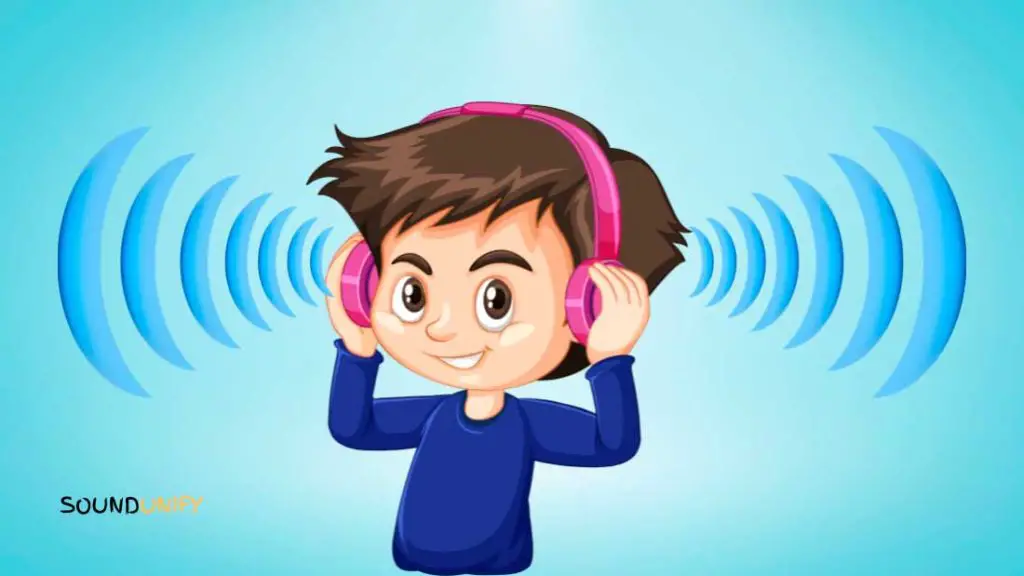As you put on your noise-canceling headphones, you hope they will make you feel relaxed and clear-sounding.
But instead, you might be left feeling uneasy and disoriented. Why do noise-cancelling headphones feel weird?
The pressure created by the sound waves can affect the air pressure in your ear canal. This can lead to discomfort or disorientation, especially if you’re not used to wearing these types of headphones.
I will go into more detail about why noise-cancelling headphones might feel strange. Also, I will guide how to reduce any discomfort you may be having.
Why Do Noise-Cancelling Headphones Feel Weird?

Noise-cancelling headphones may feel weird to some people because of many reasons.
1. Sensory Deprivation
Sensory deprivation occurs when there is a lack of sensory input or stimulation. It leads to a feeling of isolation, disorientation, and even anxiety.
Noise-cancelling headphones use active noise-cancellation technology to block out external noise by creating an opposite sound wave.
While this technology cancels out noise, it also creates a sense of sensory deprivation. It isolates the wearer from their surroundings, leading to disorientation, unease, or even mild anxiety.
2. Disrupted Balance
The headphones can disrupt the vestibular system. That handles balance and spatial orientation.
The ANC technology creates sound waves that are out of phase with external noise. This can cause a sensation of pressure or disorientation in some individuals.
This feeling is like the sensation of ear pressure during air travel or when diving deep underwater. But this feeling can be mitigated by adjusting the fit and settings of the headphones.
3. Frequency Response
Noise-cancelling headphones can affect the frequency response of the sound. This means some frequencies may be over-represented while others may be under-represented.
The result can be a sound that feels artificial or unbalanced. This can be especially noticeable in the bass frequencies, which may be boosted to compensate for external noise.
It can lead to pressure in the ears or even discomfort or pain over extended periods of use.
4. Ear Fatigue
Prolonged use of noise-cancelling headphones can also cause ear fatigue. It can lead to discomfort and a weird feeling.
The ANC technology generates sound waves that cancel out external noise. Also, creating a constant humming or hissing sound can be tiring to the ears. This can cause discomfort, especially if the headphones are worn long.
5. Psychological Factors
Psychological factors such as anxiety or stress can also contribute to a weird feeling.
These factors can cause a person to become hyper-aware of their surroundings. As a result lead to discomfort, claustrophobia, or even paranoia.
In such cases, it is essential to:
- Take a break from using the headphones
- Give oneself some time to relax
- Reduce stress levels
Mindfulness and meditation can help reduce these feelings and promote a more positive listening experience.
6. Headphones Design
The design of noise-cancelling headphones can also affect how they feel. Headphones that fit too tightly or heavily can cause discomfort or pain in the ears or head.
Similarly, headphones with poorly designed ear cups can cause pressure points around the ears. The material used in the ear pads can also contribute to discomfort for some individuals.
Especially if they are allergic to certain materials or the pads do not breathe well. It causes the ears to become hot and sweaty. So, choose noise-cancelling headphones that:
- Fit well
- Have adjustable features
- Use high-quality
- Comfortable materials
7. Environmental Factors
Environmental factors can also impact how you feel with noise-cancelling headphones.
In quiet environments, such as a library, noise-cancelling headphones can create a feeling of unnatural silence. That may be unsettling for some individuals.
Similarly, the noise-cancelling technology may not block out all external noise in loud environments, such as crowded airports.
Adjusting the headphones’ settings or using different noise cancellation levels can help create a more comfortable listening environment.
8. Pressure on Ears
The headphones can cause pressure on the ears due to their active noise cancellation technology.
This technology generates sound waves out of phase with external noise cancelling. The creation of these waves can cause a buildup of pressure on the eardrums.
As the sensation felt during air travel or underwater diving, this pressure can lead to discomfort or pain for some individuals especially if the headphones are worn for an extended period.
Adjusting the fit and settings of the headphones or taking breaks from wearing them can help reduce this feeling.
How Can Prevent Discomfort When Using Noise-Cancelling Headphones?

Discomfort when using noise-cancelling headphones can be prevented by following these tips:
1. Choosing the Right Headphones
Choosing noise-cancelling headphones that fit well and are comfortable for extended periods is essential to prevent discomfort. When selecting headphones, consider the following factors:
- Comfort: Look for headphones with soft and breathable ear pads that fit well without creating pressure points.
- Build quality: Choose headphones made from high-quality materials that are durable and well-constructed.
- Design: To ensure a comfortable fit, look for well-designed headphones with adjustable features, such as ear cup rotation or headband adjustment.
- Weight: Select lightweight headphones that do not put too much pressure on the head or ears.
- Sound quality: Choose headphones that produce clear, balanced audio free from distortion and interference.
- Battery life: Ensure the headphones have a long battery life, especially if they are noise-cancelling.
2. Proper Usage
Proper usage of noise-cancelling headphones can also help prevent discomfort. Follow these tips when using noise-cancelling headphones:
- Adjust the noise-cancellation level to fit the environment you are in. Higher levels of noise cancellation may not always be necessary and can cause discomfort in quiet environments.
- Adjust the equalizer settings to optimize the audio for your personal preferences. And reduce the feeling of unfamiliarity with the music or speech being played.
- Avoid using noise-cancelling headphones while driving or during outdoor activities. This can be dangerous and reduce your awareness of your surroundings.
3. Taking Breaks
Taking breaks from noise-cancelling headphones is essential to prevent discomfort and ear fatigue. Here are some tips on how to take breaks:
- Take a break and remove the headphones every 1-2 hours to allow your ears to rest.
- Take breaks during long listening sessions to prevent ear fatigue and discomfort.
- Practice safe listening habits by keeping the volume safe and avoiding prolonged exposure to loud sounds.
- During breaks, engage in physical activity or exercise to help promote blood flow and reduce ear discomfort.
- Use earplugs or regular headphones in quiet environments or during activities. This activity does not need noise-cancelling technology, such as reading or studying.
4. Adjusting Noise-Cancelling Levels
Adjusting the level of noise cancellation can help reduce discomfort caused by the technology. That actively reduces the noise in your ears. Finding the right level for your environment and personal preference is key. Here are some tips for adjusting the noise-cancellation levels:
- Lower the level of noise-cancellation in quiet environments or when not needed. Higher levels can cause discomfort or a strange feeling in a quiet place.
- Increase the level of noise-cancellation in loud environments or during activities that need a higher level of isolation, such as air travel or working in noisy environments.
- Experiment with different noise-cancellation levels to find the best one for you.
- Use headphones with adjustable noise-cancellation levels to allow for customization of the listening experience.
5. Using Ear Pads
Ear pads are an essential component of noise-cancelling headphones. That improves comfort while reducing pressure on the ears.
They act as a cushion between the headphone’s hard plastic or metal frame. The delicate skin around the ears distributes the pressure across a larger area.
Several types of ear pads are available that cater to different user preferences and needs. Some of the most common types of ear pads include:
- Foam: Foam ear pads, also known as memory foam, conform to the shape of the ears and provide a comfortable fit.
- Leatherette: Leatherette ear pads offer a premium feel and are usually easy to clean.
- Velour ear pads: They are soft and breathable, making them an excellent option for extended listening sessions.
When choosing ear pads, it is essential to consider factors such as:
- Size of the ear cups
- Material of the ear pads
- Thickness
- Shape
The ear pads should fit into the ear cups without causing pain or interfering with sound quality. If they are too small, they can hurt; if they are too big, they can make the sound less good.
6. Proper Headphones Positioning
Proper positioning of headphones is essential to reduce discomfort and achieve optimal sound quality.
Many users experience discomfort when the headphones are not positioned. It can cause pressure points or an uneven fit.
Here are some tips for adjusting the position of the headphones to improve comfort:
- Place the headphones over the ears and ensure they fit snugly without creating pressure points.
- Adjust the headband to ensure that it is centered on the head and distribute the weight of the headphones.
- If the headphones have rotating ear cups, adjust them to fit the shape of the ears for a more comfortable fit.
- To avoid pressure points in glasses wearers, adjust the position of the headphones to prevent interference with the glasses’ arms.
- Do not force the headphones into position or pull them on the head, as this can cause discomfort over time.
- If the headphones have a swivel or pivot joint, adjust it to fit the angle of the head to increase comfort and reduce pressure points.
By following these tips, users can adjust the position of the headphones to achieve the most comfort.
7. Taking Care of Your Ears
Taking care of your ears is crucial to prevent discomfort while using noise-cancelling headphones. Here are some tips for ear care:
- Clean your ears to prevent the buildup of excess earwax. This can lead to discomfort and even affect the sound quality of the headphones.
- Avoid using cotton swabs to clean the ears, as this can push the earwax further into the ear canal and cause damage to the eardrum.
- Practice safe listening habits by keeping the volume safe and limiting exposure to loud or high-volume sounds. This helps prevent damage to the inner ear and reduces the risk of hearing loss.
8. Using White Noise or Ambient Sound
Using white noise or ambient sound can be a helpful way to prevent discomfort when using noise-cancelling headphones.
This is because white noise and ambient sound can help reduce sensory deprivation. White noise can provide a soothing background sound that can help mask any discomfort.
Ambient sounds like low-level music can also help make the listening experience more immersive and enjoyable.
Here are some tips for using white noise or ambient sound with noise-cancelling headphones:
- Use a white noise machine or an app to generate white noise on your phone.
- Use ambient sound apps or websites that offer nature sounds, such as rain or ocean waves, to create a relaxing listening environment.
- Adjust the volume of the white noise or ambient sound to a comfortable level that does not interfere with the audio’s clarity.
- Use in-ear noise-cancelling headphones that allow for adjustable levels of ambient sound. Which can help reduce feelings of isolation and disorientation.
Can Discomfort Be a Sign of a Problem with the Headphones?

Discomfort when using noise-cancelling headphones can be a sign of a problem with the headphones.
The discomfort may result from the poor design that is uncomfortable to wear for a long time.
Common issues that can cause discomfort with noise-cancelling headphones include:
- Poor ear pad design: If the ear pads are too small, they can cause pressure points or discomfort around the ears. Similarly, if the ear pads do not fit the shape of the ear properly, they can create a weird sensation or even pain.
- Unclear Sound: If the headphones do not produce a clear and balanced sound, it can cause discomfort or headaches. This can be a sign of poor sound quality, low-quality drivers, or a problem with noise-cancelling technology.
- Poor fit: Headphones that do not fit well can cause discomfort or pain in the ears or head. This can be caused by the headphones being too heavy, too tight, or not adjustable enough to fit different head sizes.
- Faulty noise-cancelling technology: This can cause a weird sensation or increase ambient noise rather than cancelling it out. Problems with the drivers can cause this.
- Pressure points on the ears: Pressure points can be caused by poorly designed ear cups. This can cause discomfort and even pain in the ears or head. A proper fit is essential to ensure that the ear cups do not create pressure points or apply too much pressure on the ears.
How Long Does It Take to Get Used to Wearing Noise-Cancelling Headphones?
Getting used to wearing noise-cancelling headphones can vary from person to person. But it generally takes a few days to a week. During this time, the brain adjusts to the lack of ambient noise and may feel disorientated.
Here are some tips for getting used to wearing noise-cancelling headphones:
- Start with low-level noise cancellation and increase daily until you reach the desired level.
- Wear the headphones for short periods and increase the daily duration.
- Listen to familiar music or sounds to help the brain adjust to the lack of ambient noise.
- Take regular breaks and adjust the noise-cancellation level to prevent discomfort.
- Be patient and give yourself time to adjust to the new sensory input. It may take time to appreciate the benefits of noise-cancelling headphones.
Can Medical Conditions Make Wearing Noise-Cancelling Headphones Uncomfortable?
Yes, medical conditions can make wearing noise-cancelling headphones uncomfortable or even dangerous. Some of these conditions include:
1. Tinnitus
Tinnitus is when individuals experience ringing or buzzing in their ears. Noise-cancelling headphones can worsen this condition by masking external sounds and amplifying internal sounds, such as ringing or buzzing.
2. Hyperacusis
Hyperacusis is when individuals are sensitive to sound and experience discomfort or pain at normal sound levels.
Noise-cancelling headphones can exacerbate this condition by creating an isolated listening environment and amplifying internal sounds.
3. Meniere’s Disease
Meniere’s Disease is a condition that affects the inner ear and causes symptoms such as vertigo, tinnitus, and hearing loss.
These headphones can worsen these symptoms by creating a strange or disorienting sensation.
4. Ear infections
Ear infections can cause inflammation and discomfort in the ear canal. It makes noise-cancelling headphones uncomfortable or even painful.
5. Motion sickness
Motion sickness can be worsened by using noise-cancelling headphones, as isolation and lack of external sensory input can create a disorienting sensation.
6. Migraines
Certain types of sound or changes in sound levels can trigger migraines. The noise-cancelling technology in headphones can create a sensation. That can trigger a migraine in some individuals.
NB: If you have any health problems or doubts about using noise-cancelling headphones, you must talk to a doctor before using them.
FAQ
When Should You Not Use Noise-Cancelling Headphones?
There are certain situations where it is not recommended to use noise-cancelling headphones. Some examples include:
1. Driving: Wearing noise-cancelling headphones while driving can be dangerous. It can reduce your ability to hear car horns or emergency sirens.
2. Walking or cycling in busy areas: It is essential to be aware of your surroundings when walking or cycling. Noise-cancelling headphones can reduce your awareness of external sounds.
3. Performing outdoor activities: Hiking, camping, or climbing requires awareness of your surroundings and external sounds. Which can be reduced by using noise-cancelling headphones. It is better to use regular headphones or earplugs that do not block out ambient noise.
4. With infants or young children: Listening to music at high volumes can harm the developing ears of young children. It is better to avoid using noise-cancelling headphones around them instead of regular headphones with a low volume or no headphones.
Why Does Noise-Cancelling Create Pressure?
Noise-cancelling headphones create mild pressure by using noise-cancellation technology to block external sounds. This occurs because the technology requires headphones with tight seals over the ears.
As sound waves travel, this seal creates an equal and opposite pressure to external sound waves. It creates a neutral pressure in the ear.
This pressure can be uncomfortable for some people. This can cause a feeling of pressure or pain in the ear.
Why Is Pressure Feeling When Using Qc35?
The noise-cancelling technology of the headphones can cause a pressure feeling when using QC35. The ANC function creates a vacuum-like experience.
Because the headphones block out external sounds by emitting a low-level frequency, it can create a pressure sensation in some users, especially when using headphones for extended periods.
Some people may find the sensation uncomfortable, but others may not be bothered by it. It is essential to take breaks and adjust the fit of the headphones if you are experiencing discomfort.
Before you go…
After reading the article, I think to clear the drought and problems. If this does not help and you have more questions than you can ask. To solve your headphones problem, you can read the related articles.
James Dimento is a Chief-in-Editor of SoundUnify. He is a headphone enthusiast and creative writer passionate about audio technology. He has three years of experience writing about headphones and sound quality and is responsible for creating reviews and taking care of all administration.
